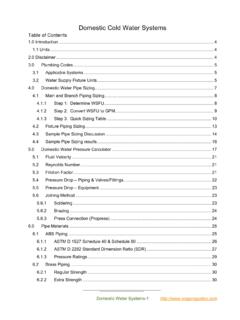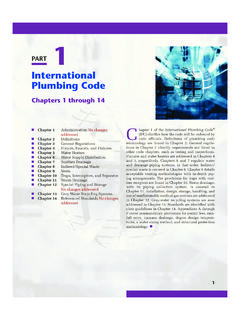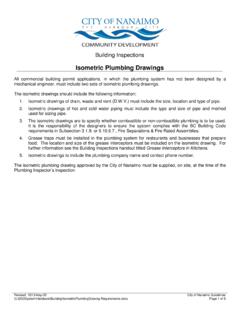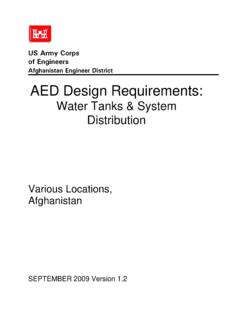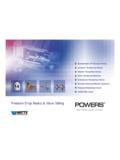Transcription of Water Flow Rate & Sizing Guide - Marlo, Inc
1 Water Flow Rate & Sizing Guidefor Commercial & Industrial UseQuality Products for Quality WaterTable of ContentsSizing Procedures ..2-3 Water Consumption Estimating Guide ..3-5 Flow Rate Estimating Chart in Gallons ..5 Water Supply Fixture Units for Public Use Fixtures ..6 Water Supply Fixture Units for Nonpublic Use Fixtures ..6 Conversion of Water Supply Fixture Units to Gallons per Minute ..7 Work Sheet for Sizing Commercial Systems ..8 Sizing Procedures1 Obtain a properly taken Water analysis A. Analyze Water with portable test kit. B. Check with local Water utility department for their Water analysis records. C. Send Water sample to Marlo, Inc. for Analysis should at least test for the following A. Hardness as CaCO3 in grains per gallon (gpg) or convert parts per million (ppm) to gpg by dividing ppm by B. Total Iron in ppm or mg/l. C. Total Dissolved Solids (TDS) in ppm or mg/l. D.
2 PH3. Determine the daily Water usage amount to be softened A. Use consumption figures from Water utility billings. (To convert billings in cubic feet to gallons multiply by ) B. Take Water meter readings. C. Use Sizing tables when Steps A or B are not Determine continuous and peak flow rates in gpm A. Use the Water Supply fixture Units (WSFU) from your State plumbing Codes and Flow Rate Tables on pages 6 and 7 to determine required flow rate. B. Obtain flow rates for continuous equipment which requires softened Water , such as boilers, reverse os-mosis from equipment specifications or manufacturer. (If flow rate data is given in pounds per hour, divide by 500 to convert to gallons per minute.) C. Install a digital readout Water meter in gpm and record peak gpms during peak Private Water supplies A. Find out the pumps capacity in continuous gpm. B. Check the pump start and stop settings.
3 C. Install a working pressure gauge if Now determine daily Water to be conditioned A. All Water conditioned. B. Hot Water Determine capacity required per day A. Capacity = (Gallons Per Day x Grains Per Gallon) Add 3 grains per gallon for each ppm of ferrous clear Water iron present. If ferrous iron content is above 2 ppm, consult factory for pretreatment that may be needed. If ferric iron is present, an iron filter is Selecting the proper unit for capacity per day A. To properly select the correct unit, go to the capacity specifications chart and find the unit which will handle the peak daily capacity (grains per day) when regenerated on low or medium salt dosages. B. Select a unit that will not regenerate any more often than every 2 - 3 days on low or medium C. Sizing systems on low or medium salting levels save up to 40% on annual salt costs plus additional Water us-age savings. Avoid Sizing equipment which will require regeneration with the high salt Analysis should at least test for the following A.
4 When Sizing for continuous flow rate, subtract the pressure drop at the operating gpm flow across the softener from line pressure. At least a 30 psi should be left for working pressure. B. When Sizing for peak flow rate, subtract the pressure drop across the softener from line pressure. At least a 20 psi should be left for working pressure. NOTE: Some automatic fixtures (such as Flushometer type toilets) have specific pressure requirements by the manufacturer which may be greater than 20 psi. C. If either (A) or (B) above is lower than the minimum allowable working pressure for the unit selected in Step # 8, select a larger softener which has a lower pressure drop at the gpm demand and capacity needed. D. Always conform to all local and state plumbing Guide is provided for estimations only when actual meter readings are unavailable. Estimate peak gpm using Sup-ply Fixture Units on page Beauty Shops One Bedroom Units - people/apt.
5 300 full line Two Bedroom Units - 3 people/apt. Three Bedroom Units - 5 people/apt. Boilers Full Line - 60 Steam boilerts require gallons of Water per Hot Only - 25 hour for each horsepower rating of the boiler. Many boilers have a condensate return and thisBarber Shops percentage should be subtracted from the full 75 full line demand to determine actual Important Checks1. Available Space - Compare dimensions of unit(s) selected with the installation space Doorways - Make sure all equipment will fit through all doorways, hallways and elevators leading from the delivery area to installation Backwash Rates - If unit is operated on a private wa-ter supply, make sure the pump will be able to maintain the backwash rate required. Drains on all installations must be able to handle the backwash flow rates of the unit(s) Special Applications - While most commercial equip-ment will produce satisfactory softened Water at 1 to 2 grains hardness leakage for apartment buildings, ho-tels, laundries, and similar applications, some applica-tions such as boiler, reverse osmosis etc.
6 May require higher quality Water of less than 3 - 5 ppm of hardness leakage. Consult the factory on these Consumption Estimating GuideMaximum Allowable Flow Rate for Copper Tube Type M-ASTM B88*1 .. gpm2 .. gpm3 .. gpm4 .. gpm*Velocities not to exceed8 feet per (Cont d) The amount remaining is your makeup per makeup Water requires further the % of operation rating to determine actual makeup per hour. Multiply this number times hours of operation per :50 Boiler60% Condensate Return75% Operation Rating24 Hours/Day50 x Gallons/Hour = Gallons x 60% Condensate - Gallons - Condensate Return = 85 Gal-lonS Makeup85 Gallons Makeup x 75%Operating Rating = Gallons Of Actual Gallons x 24 Hours/Day = 1,566 Gallons/DayIf a boiler is rated in lbs/hour figure as follows:10,000 lbs/500 = 20 less % Convert BTUs to HP multiply BTUs x .0003931 Boiler Feedwater (Makeup Requirements) gallons/hour per Horsepower = Gallons of Water evaporated/hourLbs.
7 Evaporation/hour x .12 = Gallons of Water evapo-rated/hourFeedwater makeup requirements:1. Rated in horsepower - gallons of Water evapo-rated per hour. This is then multiplied by the per-centage rating at which the boiler is operated. Example: A 300 HP boiler operated at 75% of rating = 300 x x 75% / 100% = gallons of Water evaporated/hour. Gallons per hour x hours/day = gallons/day of Lbs. of evaporation/hour x = Gallons of Water evaporated per hour. Example: 25,000 lbs. x = 3000 gallons of Water evaporated/hour Gallons/hour x hours/day = gallons per day of for Percentage of Condensate Returns:If the boiler system doesn t use condensate return, then the feedwater makeup requirements above are used to determine Sizing . When condensate returns are used, the feedwater makeup is the difference between the number of gallons of Water evaporated per hour and the number of gallons of condensate : 3600 gallons of Water evaporated per hour and condensate return of 50%; the amount of boiler feedwater makeup required is: 3600 - (50% of 3600) = 1800 gallons per hour of boiler operation for feedwater makeup.
8 Gallons per hour x hours per day = gallons per day of Alleys75 CarwashWith the variety of number of different types of carwash systems available in today s market, we advise you to consult the specific manufacturer for your Estimate:1. Multiply the number of Self Serve Bays by Multiply the number of Automatic Bays by Add together the answers from step 1 and Add the Spot Free Rinse demand (from the manu-facturer) to the total in step 3 to calculate the total Guideline:Average Gallons Per Day Automatic Bay - 6,840 Average Gallons Per Day Self Serve Bay - 600 Cooling TowersTo determine daily makeup in gallons:1. Multiply the tonnage by 4. (This includes 2 gallons/hour/ton evaporation and 2 gallons/hour/ton/bleed off.)2. Next multiply the answer in step 1 by the hours per day of Full Line16 Hot OnlyFactories35 w/Showers Full Line25 w/o Showers Full LineNOTE: Estimate any process Water AnimalsDairy Cow - 35 Cow - 12 - 2 - 4 - 12 - 2 - 10 BirdsTurkeys - 18 BirdsHospitals250 Full Line 170 Hot OnlyNOTE: Estimate air conditioning and laundry Obtain capacity (Lbs) from customer or capacity table on next Calculate usage and flow from formulas A & A = Capacity (Lbs) x = Gallons/CycleFormula B = Capacity (Lbs) x 10% = Flow Rate (gpm)5 FLOW RATE ESTIMATING CHART IN GALLONSI nstructions For Use:1.
9 Count and total the number of each type of fixture to be serviced by Water conditioning Multiply the number of each type of fixture by the unit count given for the appropriate Water supply fixture table. Private - Apartment Buildings, Trailer Parks, Group Homes, Houses, etc. Public - Office Buildings, Hospitals, Motels, Clubs, Schools, etc. NOTE: Make sure you use the correct values for hot, cold or hot & Find the total fixture count by adding the values found in Step Using the correct chart on page 6, find your total supply fixture count value in the left hand column and read across to the right to find the gpm demand. Make sure you use the correct gpm column for private or public .Example: 10 Unit Apartment (Hot Only) 10 Kitchen Sinks @ 1 = 10 10 Dishwashers @ 1 = 10 10 Bathroom Groups @ 2 = 10 10 Automatic Clothes Washers @ 1 = 10 Total SFUs = 50 GPM Demand = 28 When both private and public fixtures are present, use the predominately higher percentage of private or public to obtain your gpm Laundry Capacity TableTumbler Clothes Tumbler Clothes Tumbler Clothes Tumbler Clothes Size Capacity Size Capacity Size Capacity Size Capacity (inches) (lbs) (inches) (lbs) (inches) (lbs) (inches) (lbs)
10 30 x 16 25 36 x 42 125 42 x 96 400 44 x 126 575 24 x 36 48 36 x 54 165 42 x 108 450 48 x 84 460 30 x 30 60 42 x 42 175 42 x 126 510 48 x 96 535 30 x 36 70 42 x 48 200 44 x 54 245 48 x 120 680 30 x 42 80 42 x 54 225 44 x 64 300 48 x 126 715 30 x 48 95 42 x 64 265 44 x 72 330 54 x 84 600 36 x 30 90 42 x 72 300 44 x 84 385 54 x 96 680 36 x 36 110 42 x 84 350 44 x 96 440 60 x 96 900 MOTEL 100 Full Line 40 Hot Only NOTE: Estimate the restaurant, bar, air con-ditioning, swimming pool, and laundry facilities separately and add to room HOME COURT Estimate People/Home 60 NOTE: Estimate outside Water for sprinkling, washing cars, etc. HOMES 75 Full Line Hot Only NOTE: Estimate laundry separatelyOFFICE BUILDING 15 Full Line 2 Hot OnlyRESTAURANTS 10 Full Line 4 Hot Only 2 Cocktail Bar FacilitiesREST HOMES 175 Full LIne 100 Hot Only NOTE: Estimate laundry separatelySCHOOLS 20 Full Line w/Showers 10 Full Line w/o Showers 10 Hot Only w/Showers 4 Hot Only w/o ShowersTRAILER PARKS 100 SUPPLY FIXTURE UNITS FOR PUBLIC USE FIXTURES Water SUPPLY FIXTURE UNITSTYPE OF FIXTUREa (WSFU) Hot Cold TotalAutomatic Clothes Washer, IndividualAutomatic Clothes Washer, Large CapacityBathtub, with or without Shower HeadCoffeemakerDishwasher, CommercialDrink DispenserDrinking FountainGlass FillerHose Bibb: 1/2 diameter 3/4 diameterIcemakerLavatoryShower, per HeadSinks.
